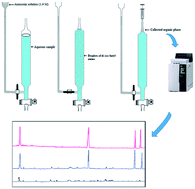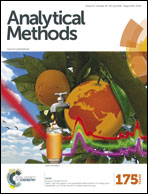Development of a simple and efficient pretreatment technique named pH-dependent continuous homogenous liquid–liquid extraction
Abstract
In this study, a simple and rapid sample pretreatment technique named pH-dependent continuous homogenous liquid–liquid extraction followed by gas chromatography-flame ionization detection has been developed for the extraction, preconcentration, and determination of four pesticides including diazinon, oxadiazon, bromopropylate, and fenazaquin in fruit juice and vegetable samples. In this method, two parallel glass tubes with different diameters and lengths are connected with a Teflon stopcock and used as an extraction device. Initially a basic organic solvent with low solubility in water (amine) as an extraction solvent is mixed with acidified deionized water containing the analytes and a homogenous solution is obtained. The homogenous solution is filled into one side (wide and short tube) of the extraction device. The other side (narrow and long tube) is filled with an ammonia solution. Then, the stopcock is slowly opened and the solution of ammonia is flowed into the other tube containing the homogenous solution under hydrodynamic pressure. By this action, an acid–base reaction occurs, so the homogenous solution is broken and the target analytes are extracted into the produced fine droplets of the organic solvent. The droplets move up through the aqueous phase to the top of the wide tube and form a separated layer owing to the low density of the organic phase compared to water. Several important parameters affecting the performance of the proposed method such as the type and amount of extraction solvent, ionic strength, and extraction time were investigated and optimized. Under the optimum extraction conditions, high enrichment factors (1220–1740, 407–580, and 244–348 for deionized water, fruit juices, and vegetable samples, respectively) and good extraction recoveries (61–87%) were obtained. Also, the method showed low limits of detection within the range of 0.12–0.32 μg L−1. The repeatability of the method was investigated at two concentrations of 20 and 50 μg L−1 of each analyte and relative standard deviations were obtained between 4 and 6% for six repeated determinations. Finally fruit juice and vegetable samples were successfully analyzed using the proposed method.


 Please wait while we load your content...
Please wait while we load your content...